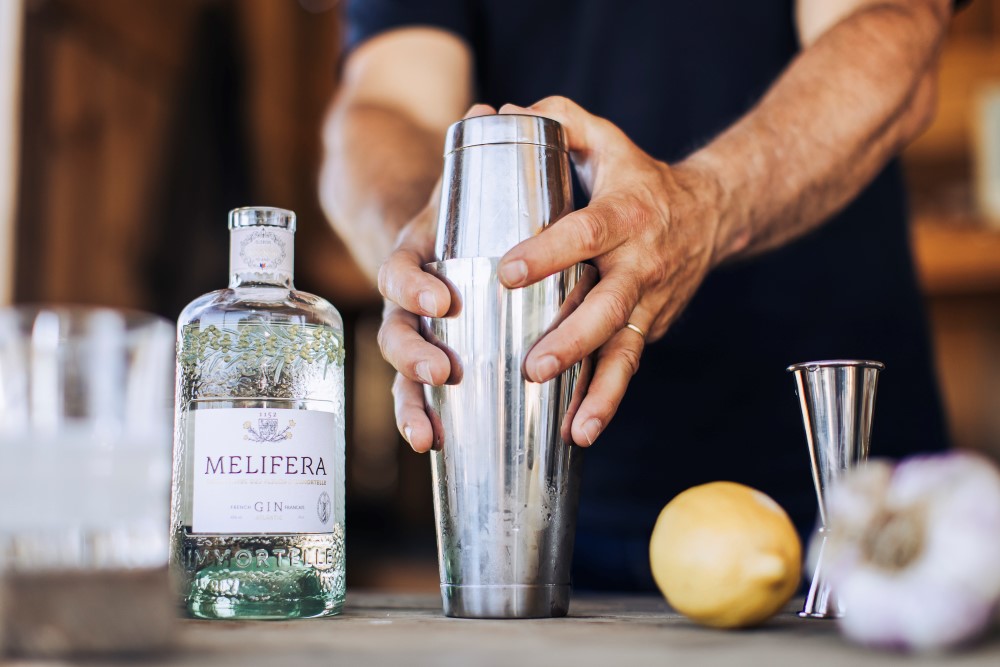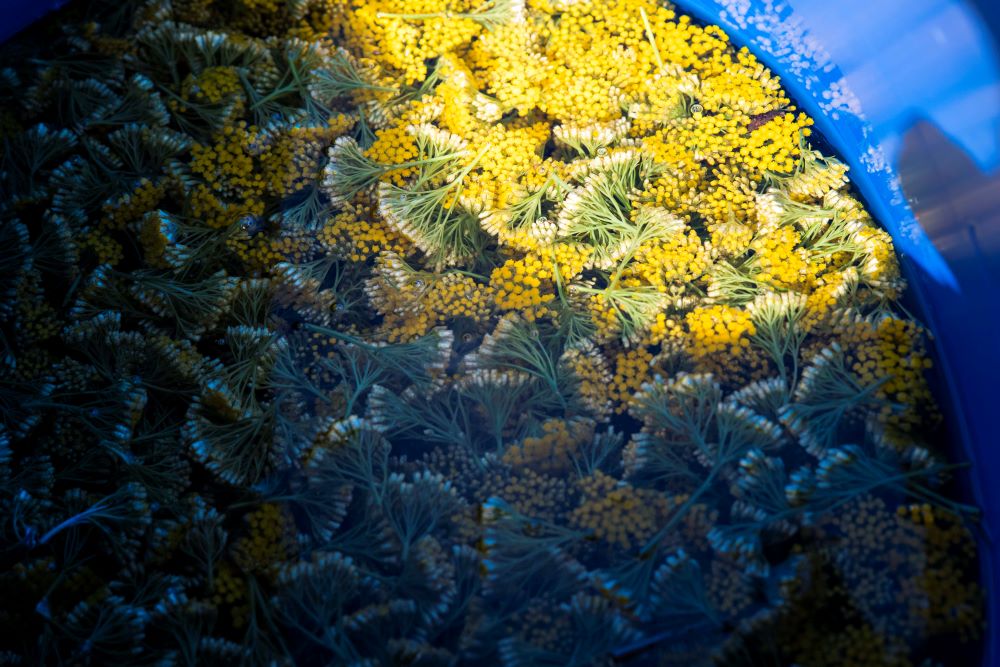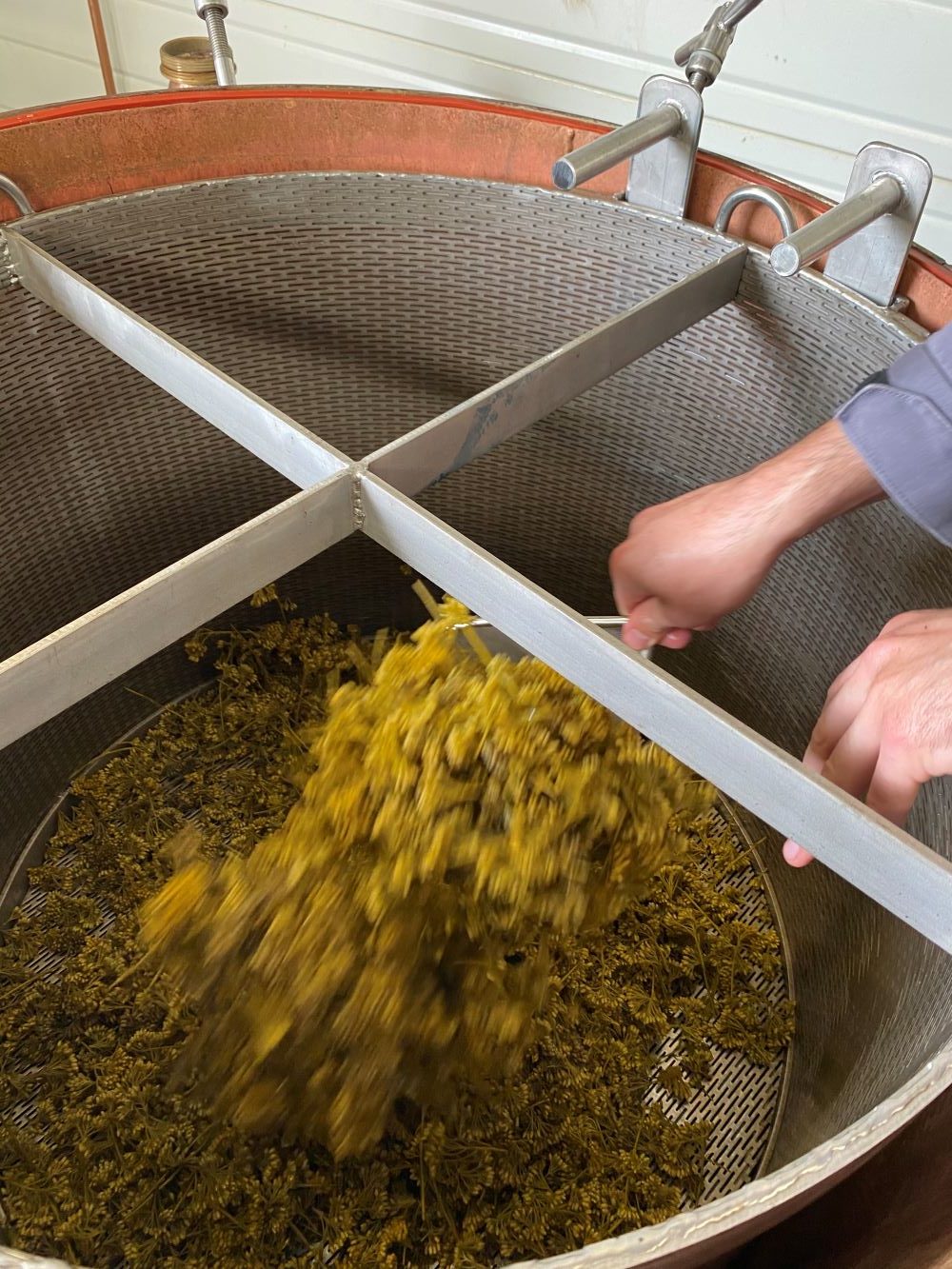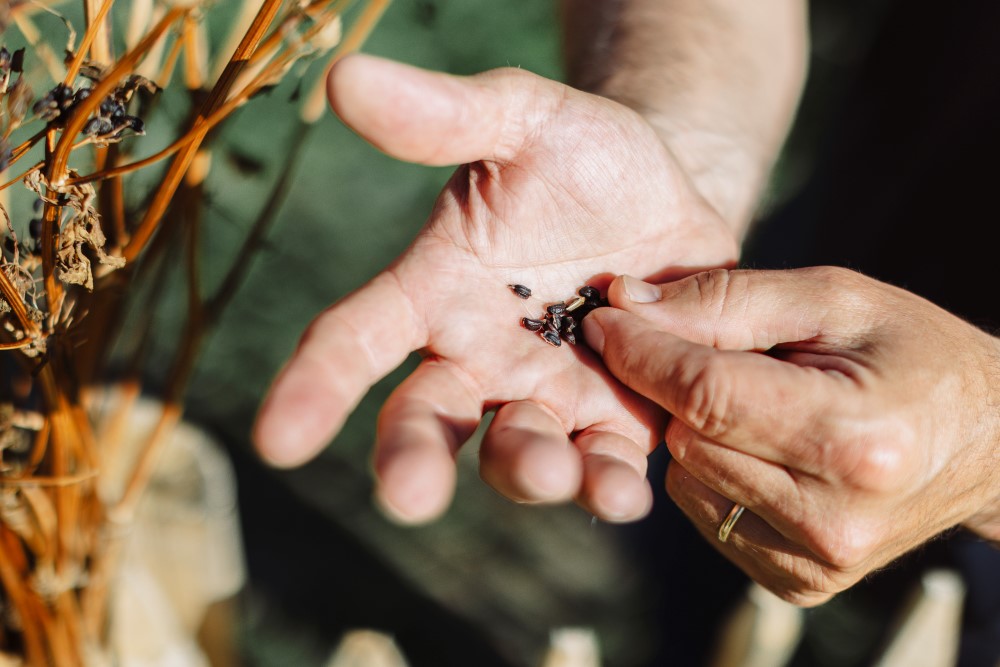Discover the secrets of making gin with Maxime Ceyral, brewery and distillery manager
Have you ever had the incredible opportunity to push open the door of a craft distillery for a private tour? Take a behind-the-scenes look at how a unique and aromatic French Gin is created! It’s a tempting experience, you have to admit. But it’s much more than that. Let our expert Maxime Ceyral, head of the brewery and distillery at SVE, the Société des Vins et Eaux-de-vie in Chevanceaux, guide you through the unusual, invigorating and surprising process. Distillation, infusion, blending, volume of alcohol, organic gin and floral strength, we reveal 10 incredible secrets for making Melifera gin. You’ll also find out why our immortelle gins are exceptional French spirits. All the secrets? Well, almost… we’re keeping a few secrets to keep you dreaming, and to surprise you!
©Melifera
1. How Gin is made: What exactly is this spirit? Genesis and historical facts
To begin with, let’s take a step back in time to the beginnings of an original aperitif. Let’s travel back to the Netherlands in 1495.
It was here that a brandy made from cereals and malt wine was first flavoured with juniper berries.
And so Genever was born.
It quickly became a huge success, crossing the North Sea to tantalise the taste buds of the British. But with brandy banned on this side of the Channel, the English soon set about making their own alcohol.
Making Gin: Did you know?
To be entitled to bear the name ‘gin’, a spirit must meet two conditions:
- Firstly, it must have a minimum alcohol content of 37.5% in Europe and 40% in the United States.
- Secondly, it must contain juniper berries.
“Juniper berries are to gin what absinthe is to vermouth. You can’t call a spirit ‘gin’ if it doesn’t contain juniper berries. In other words, a distilled gin must contain distilled juniper berries, not flavouring.”
Maxime Ceyral, expert distiller
©Melifera
2. Gin production methods
But before we get to the heart of the matter and reveal the secrets behind the making of gin, let’s take a look at the recipe for this highly original French aperitif.
- Gin is a white spirit with a neutral base of 96 degrees.
It’s called neutral because the alcohol concentration is so high that it’s almost impossible to tell which of the basic ingredients has been distilled. This is most often grain alcohol, such as wheat, barley or rye, but also sometimes beetroot or grapes.
- Once this common base has been established, the spirit is personalised, with a flavouring phase for ‘entry-level’ gins and re-distillation for others.
- This is when the notion of appellation comes into play.
- Gin is classified into families, which make it easy to understand the type of production and quality of the product purchased.
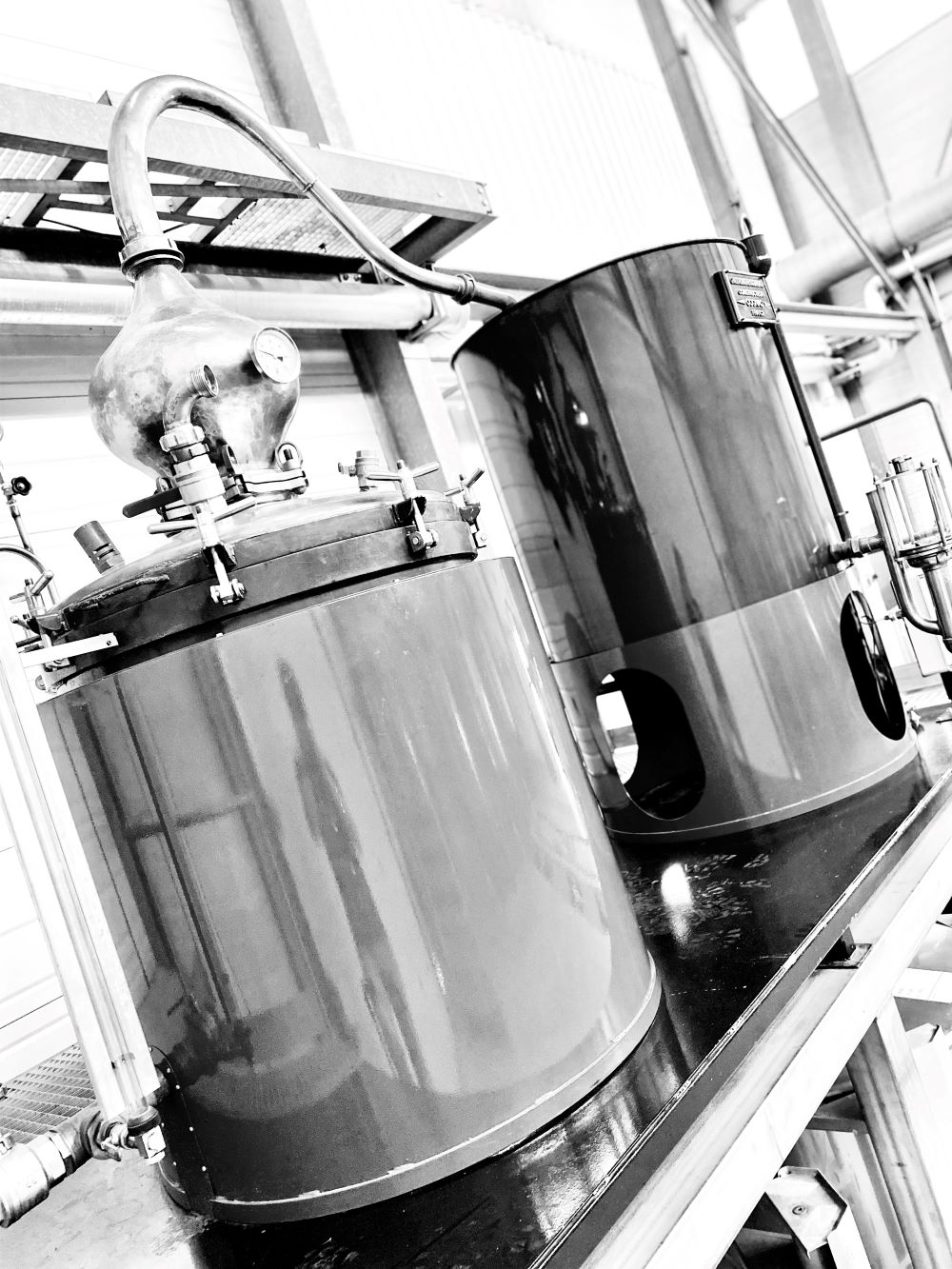
©Melifera
Gin is made in three main families
- Compound gin. This is undoubtedly the cheapest on the market. It is a concentrate of gin flavour, with juniper berries of course, which is then added to neutral alcohol.
- Distilled Gin. As you might expect, this one is more refined. The juniper berries and botanicals are placed in the still, just above the brandy, to allow the vapours to pick up the aromas. Our Melifera Gin is a Distilled Gin.
- London Dry Gin. This gin is also distilled. Here, the ‘dry’ aspect of the production process is emphasised, as the addition of artificial flavourings is prohibited. If a little sugar is added, the result is a new name: London Gin.
Other families used to make gin include :
- Yellow Gin, a spirit preserved in oak casks, which gives it its amber colour.
- Sloe Gin, a liqueur made from gin infused with sloes.
- Old Tom Gin, the ancestor of London Gin but much sweeter.
3. Making Gin Melifera: research and development first and foremost
So, once you’ve got the basics down, how do you go about it?
“In a nutshell, you take the neutral alcohol and the plants. We put them together until we get an infusion. This infusion, boiled in the still, produces three products: the heads, the heart and the seconds. Only the heart is used in the final product.”
Maxime Ceyral
OK, that’s the basic instructions. But before that, what exactly happens?
Well, hours of research go into concocting a trendy and original aperitif:
- Creating the product.
- Selecting the botanicals (plants or herbs) that will go into the composition of the spirit alongside the immortelle flower, queen of the
- French Gin Melifera.
- Testing the alcohol level that will allow each plant to reveal its best qualities.
- Perfecting the blend to finalise the Melifera product. This is the art of the master distiller.
Immortelle flowers macerated in neutral alcohol ©Melifera
4. A story of passion through the making of Gin Melifera
Passionate about distillation and the world of spirits, Maxime Ceyral doesn’t mince his words:
- On his expertise in designing our French gin:
“Selecting and knowing how to get the best out of these plants”.
And with 9 botanicals included in the composition of Melifera, there’s a lot of work to be done!
- At every stage of the gin-making process, expertise, nose, experience and precision come together to produce an excellent final product.
“The base alcohol used to infuse the botanicals is organic wheat grain alcohol. It has an ethanol content of 96% by volume. We use this alcohol either raw or reduced with demineralised water to make the infusions. Depending on the botanical, the alcohol content may be lower than 96% to avoid damaging the plant. Some botanicals will be extracted at very high alcohol content, but for others, too high an alcohol content will only reveal defects. That’s why at Melifera, depending on the botanicals we infuse, we adjust the alcohol content. That’s all the research we did before creating the product.”
5. Making Gin Melifera: the art of recovering the heart of distillation
Once the neutral alcohol has been chosen, we move on to the distillation stage.
To distil a plant, particularly immortelle, you need to infuse it slightly beforehand.
A quick aside from Maxime on the process of making our Melifera gin from organic immortelle:
“Infusion is the same principle as putting a tea bag in a cup with water. More precisely, in the case of tea, it’s the heat of the water that extracts the plant’s aromas. And the temperature of the water is very important. As is the level of alcohol in the infusion, which depends on the botanical.”
During the infusion stage, the alcohol and botanicals are placed together in a container for as long as it takes for the botanicals to express all the desired qualities.
“Once this infusion is ready, if it is not used raw in the final product, we put it in a still to distil and concentrate it. Our expertise as distillers comes into play when the infusion is brought to the boil, at which point we have to work on the product according to two principles: concentration of the aroma and sorting.”
Similarly, the first litres to come out of the still are discarded as being too strong. In other words, they don’t have the quality required to make an exceptional French organic gin. It is just after these first litres that the heart of the distillation is obtained. This is what will be used in the final product.
Perfect mastery of the gin-making process through selective distillation
The pouring of the distillation core gives rise to the wrong aromas. As a result, the distiller’s entire job is based on his ability to detect and remove these unsuitable essences to make a perfect organic French gin.
To do this, it is essential to use two specific containers:
- One to isolate the heart of the distillation process.
- A second to collect the other essences, known as “distillation seconds”. These will be used in a subsequent infusion to obtain a new distillation heart.
In short, the heads and seconds go back with neutral alcohol to make an infusion. The heart is used alone in the production of Melifera gin.
©Melifera
6. Botanicals distilled one by one to make Gin Melifera
At Melifera, we pride ourselves on having a very special way of creating our French organic gin.
Before blending, the botanicals are distilled plant by plant, not all together.
As our expert Maxime explains:
“Some plants, like immortelle or juniper berries, are distilled. Others, like maceron, a very powerful and clean product, are just infused. It’s also important to remember that not all the plants are harvested at the same time of year. So when I have a plant, I infuse it in alcohol. Once I’m satisfied with my infusion, I separate the botanicals from the alcohol. The botanicals will then be composted and the alcohol stored before the final blend is made. Once we’ve blended our different botanicals, we’ll have to reduce the alcohol content with demineralised water.”
When choosing between infusing or distilling a plant, there is also the essential notion of visual appearance, particularly colour, which comes into play.
The problem with infusion is that it’s coloured. However, for gin, we want a transparent, even translucent product. That’s why by distilling certain plants, we can eliminate the colour.
Maceron, one of the 9 botanicals used in the recipe for Melfiera gin ©Melifera
7. Making Gin Melifera: a certain precision
It takes around two months to create a bottle of Melifera gin, from the time the first flowers are harvested until the first bottle comes off the line.
The just-harvested flowers are immersed in the alcohol and macerated for around a week before distillation.
The final alcohol content is 43%. That’s why we work out the alcohol content according to the optimum blend of botanicals.
“43% is the level at which Melifera expresses itself best. It’s a guarantee of quality.”
Maxime Ceyral
8. Blending, a key stage in the production of Gin Melifera
Clearly, blending is one of the key stages in the making of Melifera organic French gin.
In fact, for us, it’s all a question of dosage and striking the right balance between the different botanicals. As in perfumery, it’s a job where you need a nose, as well as practice and experience, that goes without saying!
“For some botanicals, we use infusions with very strong alcohols. With juniper berry distillates, we’re talking about 80% alcohol at the heart of the distillation. Imagine putting that in your mouth! So we work with the nose. If we really need to taste, we’ll reduce the distillate by adding a little demineralised water. To find the taste. Our work can be compared to that of a perfumer, where the person who does the blending really works with the nose. Throughout the day, we come back to the tasting glasses to see how it’s evolving. If it’s morning or afternoon, for example, you won’t get the same sensations.”
9. Making Melifera Gin: organic ethics essential at every stage
Melifera, more than just a name.
A French organic gin made 100% by hand:
- Use of natural aromas.
- Personal distillation of small batches of plants.
- Increased knowledge of each product, where it comes from, how it’s grown and how it’s harvested.
- Collecting immortelle flowers on the island of Oléron with Maxime
- Ceyral, our expert distiller.
- Progressive use of our own juniper berries.
Yes, that’s it, local know-how for a Made in Melifera gin aperitif.
10. Melifera, floral power and the little secrets of making gin
Is gin bitter? Yes, but not only!
The proof lies in the fact that this spirit is becoming an increasingly popular choice for original French aperitifs.
Today, gins come in an infinite variety of flavours. From one brand to another, you can opt for a more bitter side for some, or a more floral, fruity or spicy flavour, with more or less sweetness for others.
There’s something for everyone! As Maxime so rightly confides.
“What people expect most at the moment in France is the floral side. It’s the trend that stands out and sets quality French gins apart. The aim of upstream spirits research is to find that power. At Melifera, it’s the typical immortelle flower that gives the product its character and enhances the juniper berry. All the other botanicals dress it up and make the final product more complex. This plant, which is also known as a curry plant, is so pleasant to work with, with its floral, warm side”.
That says it all.
Can we reveal all the secrets behind the making of Melifera gin?
“There’s a huge amount of research and development that goes into making Melifera gin. How many botanicals? For each botanical, what percentage of alcohol is used to infuse the plant? How many plants per litre of alcohol? How should distillation be managed, particularly the infusion of immortelle?”
Maxime Ceyral
These are just some of the parameters that go into the secrets of making Melifera gin.
“There’s a way of making the distillate, the heart of distillation, and being able to reproduce it over the years. Even if the immortelle flowers are different from one year to the next, depending on the rain and sunshine. Each time, we have to find the precise moment to stop the heart of the distillation”.
You’ve just delicately penetrated Melifera’s well-kept secrets for the production of an exceptional French gin. Through its incredible history, its unique methods of conception and the exceptional flavours that can enhance it, this original aperitif is the result of a well thought-out, but above all, excellently mastered process. Research and development, combined with a passion for the craft and a desire to do things well while preserving ecosystems, have made Melifera a pioneer in French organic gin made from immortelle flowers. So many little mysteries to keep you dreaming and travelling.
©Melifera

